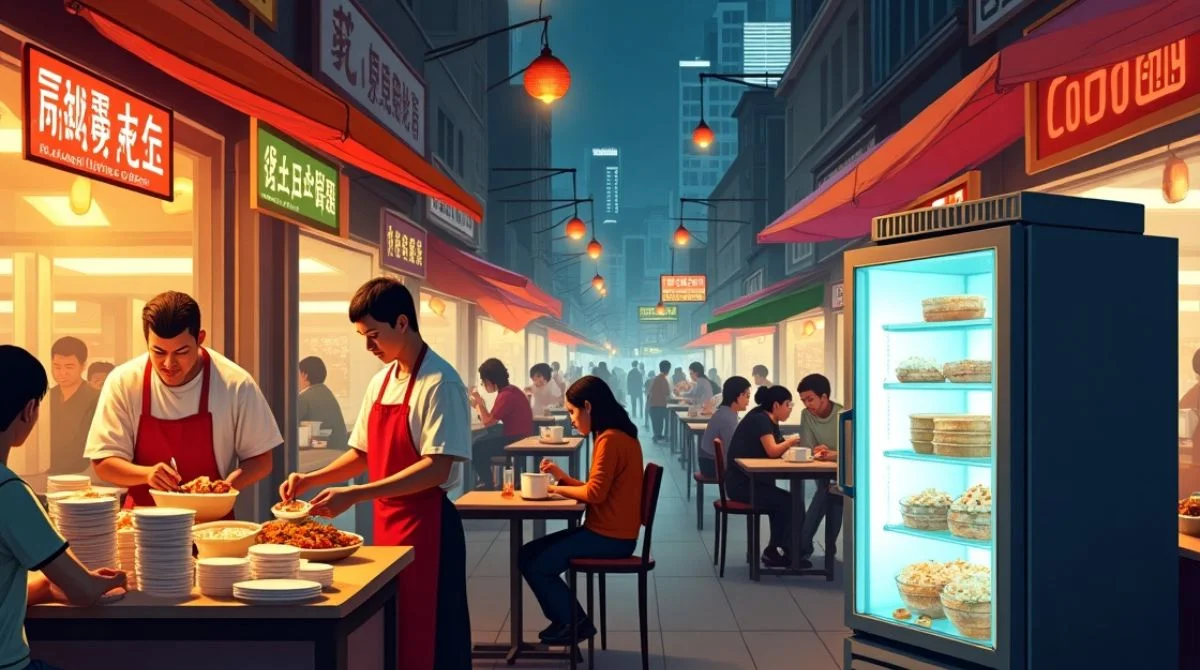The Allure of Chinatown’s Hawker Culture
Quick Taste of History
Chinatown hawker centers, especially in cities like Singapore, Kuala Lumpur, Bangkok, and San Francisco, are epicenters of food culture. For decades, they’ve offered:
- Affordable meals
- Unique local flavors
- Community spaces for all walks of life
The Cultural Roots of Leftover Consumption
A Legacy of Frugality
In many Asian cultures, wasting food is more than a faux pas, it’s a moral misstep. Grandparents often remind us to “clean your plate” because food represents prosperity, gratitude, and hard work. This ethos, born from times of scarcity, still lingers in Chinatown’s hawker centers. For some, especially older generations, consuming leftovers isn’t just practical, it’s a way to honor those values.
Take Mr. Wang, an 84-year-old Singaporean who made headlines in 2024 for eating leftovers at People’s Park Centre. He wasn’t driven by poverty but by a belief that wasting food is wrong. “I thought it was a waste,” he told reporters, echoing a sentiment shared by many.
Community and Sharing
Hawker centers aren’t just places to eat, they’re social hubs where strangers share tables, stories, and sometimes food. This communal spirit extends to leftovers. In some cases, kind-hearted diners buy meals for those they see collecting leftovers, while hawkers quietly set aside unsold dishes for regulars who can’t afford to pay full price. It’s a subtle, unspoken system of care that keeps communities tight-knit.
Why Does Food Waste Happen at Hawker Centers?
The Scale of the Problem
Food waste is a global crisis. According to the Food and Agriculture Organization (FAO), about one-third of all food produced worldwide, roughly 1.3 billion tons, is wasted annually. In Singapore alone, hawker centers contribute to an estimated 800,000 kilograms of food waste each year. Chinatown’s bustling stalls, with their generous portions and high turnover, are no exception.
What Drives Waste?
Several factors contribute to food waste at hawker centers:
- Overproduction: Hawkers often prepare large batches to meet peak demand, leaving unsold food at day’s end.
- Oversized Portions: Generous servings are a hallmark of hawker culture, but diners sometimes can’t finish what’s on their plate.
- Consumer Behavior: Tourists may order multiple dishes to sample, leaving portions uneaten. Locals, too, can overestimate their appetite.
- Strict Regulations: In places like Singapore, food safety laws prevent vendors from donating or reselling certain unsold items, leading to waste.
The Hidden Cost of Food Waste
Hawker leftovers may seem small-scale compared to restaurant chains, but across entire cities, the impact adds up:
- Economic Losses: Unsold food = lost income. Many stallholders throw away dishes that cost real time and money to prepare.
- Environmental Strain: Decomposing food emits methane, a potent greenhouse gas. Food waste also means wasted water, labor, and packaging resources.
- Ethical Dilemma: While food is tossed daily, many families struggle with hunger or food insecurity, even within walking distance of these hawker centers
Who Consumes Hawker Leftovers?
A Diverse Group with Varied Motivations
The people engaging in leftovers consumption aren’t a monolith. They span a wide spectrum, each with their own reasons:
- Low-Income Workers: Migrant workers, cleaners, or others with tight finances may discreetly collect leftovers to make ends meet.
- Sustainability Advocates: A growing group of eco-conscious diners, often younger, see leftovers consumption as a protest against food waste. Some identify as “freegans,” rejecting consumerism by eating what others discard.
- Curious Experimenters: Believe it or not, some people try leftover consumption out of curiosity or as a social experiment, especially students studying urban poverty or food systems.
The Unwritten Rules
Despite its taboo nature, leftovers consumption often follows an informal code to maintain hygiene and respect:
- Avoid Contaminated Food: Never touch plates with chewed bones or used utensils.
- Wait for Privacy: Collectors typically wait until diners leave to avoid embarrassment.
- Stay Discreet: Many act during off-peak hours to avoid drawing attention.
- Clean Up: Some tidy the table afterward to show respect for the space and staff.
These unwritten rules highlight the delicate balance between necessity and dignity, ensuring the practice remains as respectful as possible.
Can Chinatown Leftovers Be Rescued?
Yes but it takes creativity, cooperation, and policy support. Here are some promising solutions and success stories:
- Food Rescue Programs: In cities like Singapore and Hong Kong, groups like Food Rescue Sengkang or Feeding Hong Kong collect unsold food from hawkers and deliver it to shelters or community fridges.
- Cold Chain Storage: Some stalls are partnering with food-tech startups to install mini fridges that keep food safe longer allowing for end-of-day sales or donations.
- Food Waste Apps: Apps like Olio, Too Good To Go, or Treatsure connect vendors with consumers looking for discounted “last call” meals.
- Public Education Campaigns: Workshops, signage, and media content help reduce the stigma of eating leftover or rescued food, highlighting its value and safety when handled correctly.
The Benefits of Consuming Leftovers
Environmental Impact
Every plate of leftovers consumed is a small victory for the planet. Food waste in landfills produces methane, a potent greenhouse gas. By keeping food out of the trash, leftovers consumption reduces emissions and conserves resources like water and energy used in food production. In Chinatown, where high volumes of food are prepared daily, even small efforts add up.
Economic Advantages
For hawkers, selling or repurposing leftovers means recovering costs that would otherwise be lost. Discounted “last call” deals attract budget-conscious diners, boosting revenue. For consumers, affordable leftovers provide access to nutritious meals without breaking the bank, especially for low-income groups.
Social Good
Leftovers consumption fosters community resilience. Whether it’s a hawker donating unsold food to a charity or a diner sharing a meal with someone in need, these acts strengthen social bonds. Organizations like Food Bank Singapore and Willing Hearts amplify this impact by collecting surplus food and distributing it to vulnerable populations.
The Challenges and Controversies
Health and Hygiene Concerns
Let’s address the elephant in the room: is eating leftovers safe? The answer depends on how the food is handled. Untouched, properly stored leftovers from professional kitchens are generally safe, says Dr. Melissa Tan, a food safety expert. But food left on tables for too long risks contamination, especially in humid climates like Singapore’s.
To minimize risks:
- Stick to dry foods (e.g., bread, fried items) over saucy dishes, which attract bacteria.
- Avoid seafood or perishable items that spoil quickly.
- Check for signs of spoilage, like odd odors or textures.
Social Stigma
For many, leftovers consumption carries a stigma tied to poverty or desperation. Media coverage, like the 2024 story of Mr. Wang, often sparks polarized reactions some express compassion, others disgust. This stigma can discourage people from openly participating or supporting the practice, even when it’s done safely and ethically.
Ethical Dilemmas
Is it right to eat someone else’s leftovers? Should hawkers encourage this practice or focus on preventing waste altogether? These questions spark heated debates. Some argue that leftover consumption empowers individuals to fight waste, while others see it as a band-aid for deeper issues like poverty and food insecurity. The truth likely lies in a mix of both perspectives.
Sustainable Alternatives to Leftover Consumption
While consuming leftovers directly from tables has its place, there are safer, more structured ways to tackle food waste in Chinatown. Here are some inspiring alternatives:
Food Rescue Programs
Nonprofits like Food Rescue Sengkang and Willing Hearts collect unsold food from hawker stalls and redistribute it to shelters, low-income families, and community centers. These programs ensure food is handled safely and reaches those who need it most.
Food-Sharing Apps
Technology is changing the game. Apps like OLIO and Treatsure connect hawkers with consumers willing to buy discounted surplus food. In Singapore, platforms like these are gaining traction, making it easier to redistribute meals before they’re wasted.
Community Fridges
Some Chinatowns, like Penang’s, have embraced community fridges where hawkers and diners can leave surplus food for anyone to take. These fridges operate on trust, fostering a sense of shared responsibility.
Creative Repurposing
Hawkers are getting crafty. Unsold rice becomes porridge, leftover meats turn into fried rice, and day-old dumplings find new life in soups. These practices not only reduce waste but also showcase culinary ingenuity.
Policy Changes
Governments are stepping up, too. Singapore’s National Environment Agency promotes food waste reduction through campaigns like “Love Your Food” and supports policies that make it easier for hawkers to donate unsold food safely.
Practical Tips for Diners: How to Reduce Food Waste
You don’t have to eat someone else’s leftovers to make a difference. Here are practical ways to be part of the solution at Chinatown hawker centers:
Order Mindfully
- Start Small: Order smaller portions if you’re unsure about your appetite. Many hawkers offer half-servings.
- Share Dishes: Dining with friends? Split a few plates instead of ordering individually.
- Ask Questions: Not sure about portion sizes? Chat with the hawker to avoid over-ordering.
Take Leftovers Home
- Bring Containers: Carry a reusable container to pack uneaten food.
- Ask for Eco-Friendly Packaging: Many hawkers now offer sustainable takeaway boxes.
- Store Properly: Refrigerate leftovers within two hours and reheat to 165°F (74°C) before eating.
Support Sustainable Hawkers
- Buy Last-Call Deals: Look for discounted leftovers at the end of the day.
- Choose Eco-Conscious Stalls: Some hawkers partner with food rescue programs give them your business.
- Spread the Word: Share your favorite sustainable hawkers on social media to boost their efforts.
Get Involved
- Join Food Rescue Groups: Volunteer with organizations that redistribute surplus food.
- Use Apps: Download food-sharing apps to find discounted meals near you.
- Advocate for Change: Support policies that make it easier for hawkers to donate food safely.
Success Stories in Chinatown
Singapore’s Food Bank
Food Bank Singapore’s “Bread Run” collects unsold bread and other items from hawker stalls and bakeries, redistributing them to families in need. In 2024, they diverted thousands of kilograms of food from landfills, proving that small actions can have a big impact.
Penang’s Community Fridges
In Penang, community fridges have popped up near hawker centers, allowing vendors and diners to share surplus food. These fridges have become a symbol of trust and generosity, reducing waste while feeding the hungry.
Hong Kong’s Discount Deals
In Hong Kong’s Chinatown hawker stalls, some vendors offer “last call” discounts on unsold dishes, attracting students and workers looking for cheap eats. This practice not only cuts waste but also builds loyalty among customers.
Hawker Waste Around the World
This issue isn’t unique to one Chinatown, it’s global. From New York’s Canal Street to Melbourne’s Little Bourke Street, hawker-style food is booming, and with it, leftover concerns.
Global Ideas Worth Borrowing:
- Japan’s “mottainai” culture emphasizes avoiding waste out of respect
- France mandates that large food vendors donate leftovers
- Taiwan invests in high-efficiency composting systems for food courts
Future of Chinatown Hawker Leftovers Consumption
Technology’s Role
The future looks bright, thanks to innovation. AI-driven inventory management can help hawkers predict demand more accurately, reducing overproduction. Food-sharing apps are expanding, connecting more vendors with consumers. Even blockchain technology is being explored to track food safety during redistribution.
Cultural Shifts
Younger generations are reshaping the narrative. Gen Z and Millennials, with their focus on sustainability, are normalizing practices like leftovers consumption and food sharing. Social media amplifies these efforts, turning once-taboo topics into mainstream conversations.
Policy and Community Action
Governments and NGOs are increasingly supportive. From subsidies for sustainable hawkers to public awareness campaigns, the push for food waste reduction is gaining momentum. Grassroots movements, like community fridges and food rescue groups, are also expanding, creating a more inclusive food system.
Conclusion
Chinatown hawker leftovers consumption is more than a quirky urban practice, it’s a window into the heart of food culture, sustainability, and community. By understanding this practice, we can all play a role in reducing food waste, supporting local vendors, and building a more compassionate food system.










